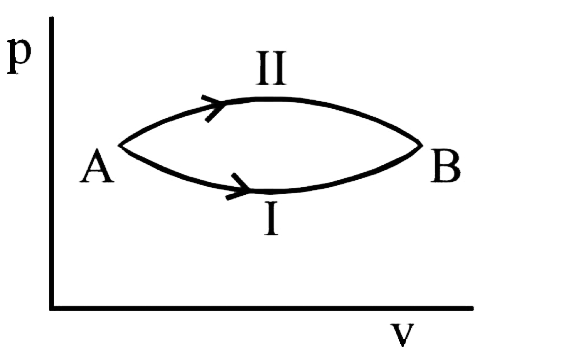If ΔH is the enthalpy change and ΔU the change in internal energy accompanying a gaseous reaction, then
ΔH is always greater than ΔU.
ΔH is always less than ΔU.
ΔH<ΔU only if the number of mole of the products is less than that of the reactants.
ΔU<ΔH only if the number of mole of the reactants is less than that of the products.
To solve the problem regarding the relationship between the enthalpy change (ΔH) and the change in internal energy (ΔU) for a gaseous reaction, we can follow these steps:
1. Understand the Definitions:
- ΔH (Enthalpy Change): This is the heat content change of a system at constant pressure.
- ΔU (Change in Internal Energy): This is the total energy change of a system, which includes kinetic and potential energy.
2. Establish the Relationship:
- The relationship between ΔH and ΔU for a gaseous reaction can be expressed by the equation:
ΔH=ΔU+ΔN⋅RT
where:
- ΔN = number of moles of gaseous products - number of moles of gaseous reactants
- R = universal gas constant (8.314 J/(mol·K))
- T = temperature in Kelvin
3. Determine ΔN:
- Calculate ΔN:
- If ΔN=0: This means the number of moles of gaseous products equals the number of moles of gaseous reactants. In this case, the equation simplifies to:
ΔH=ΔU
- If ΔN>0: This indicates that there are more moles of gaseous products than reactants. Thus, we have:
ΔH>ΔU
- If ΔN<0: This indicates that there are fewer moles of gaseous products than reactants. Hence:
ΔH<ΔU
4. Conclusion:
- The relationship between ΔH and ΔU depends on the value of ΔN:
- If ΔN=0, then ΔH=ΔU.
- If ΔN>0, then ΔH>ΔU.
- If ΔN<0, then ΔH<ΔU.
- ΔH (Enthalpy Change): This is the heat content change of a system at constant pressure.
- ΔU (Change in Internal Energy): This is the total energy change of a system, which includes kinetic and potential energy.
- The relationship between ΔH and ΔU for a gaseous reaction can be expressed by the equation:
ΔH=ΔU+ΔN⋅RT
where:
- ΔN = number of moles of gaseous products - number of moles of gaseous reactants
- R = universal gas constant (8.314 J/(mol·K))
- T = temperature in Kelvin
- Calculate ΔN:
- If ΔN=0: This means the number of moles of gaseous products equals the number of moles of gaseous reactants. In this case, the equation simplifies to:
ΔH=ΔU
- If ΔN>0: This indicates that there are more moles of gaseous products than reactants. Thus, we have:
ΔH>ΔU
- If ΔN<0: This indicates that there are fewer moles of gaseous products than reactants. Hence:
ΔH<ΔU
- The relationship between ΔH and ΔU depends on the value of ΔN:
- If ΔN=0, then ΔH=ΔU.
- If ΔN>0, then ΔH>ΔU.
- If ΔN<0, then ΔH<ΔU.
Topper's Solved these Questions
- THERMODYNAMICSBOOK - CENGAGE CHEMISTRY ENGLISHCHAPTER - THERMODYNAMICSEXERCISE - Multiple correct Answer Type
2 Videos
- THERMODYNAMICSBOOK - CENGAGE CHEMISTRY ENGLISHCHAPTER - THERMODYNAMICSEXERCISE - Exercises (Single Correct)
62 Videos
- THERMODYNAMICSBOOK - CENGAGE CHEMISTRY ENGLISHCHAPTER - THERMODYNAMICSEXERCISE - Exercises (Linked Comprehension)
74 Videos
- STOICHIOMETRYBOOK - CENGAGE CHEMISTRY ENGLISHCHAPTER - STOICHIOMETRYEXERCISE - Archives Subjective
33 Videos
Similar Questions
If ΔH is the change in enthylpy and ΔU, the change in internal energy accompanying a gaseous reactant then
View SolutionThe change in the internal energy of a substance
View SolutionA mixture of 2 moles of CO and 1 mole of O2, in a closed vessele is ignited to convert the CO to CO2 if ΔH is the enthalpy change and ΔU is the change in internal energy then:
View SolutionEnthalpy change equal internal energy change when
View SolutionWhy is the enthalpy considered more useful than internal energy in chemical reactions ?
View SolutionThe enthalpy change of a reaction does not depend on
View SolutionChange in internal energy in an isothermal process for ideal gas is
View SolutionIn a reversible isothermal process, the change in internal energy is :
View SolutionThe magnitude of ethalphy changes for reversible adiabatic expansion of a gas from volume V1 to V2(in L)is ΔH1 and for irreversible adiabatic expansion for the same expansion is ΔH2. Then
when ΔU1 and ΔU2 are the changes in magnitudes for the internal energy of gas in the two expansions.
View SolutionA system goes from A and B via two processes. I and II as shown in figure. If ΔU1andΔU2 are the changes in internal energies in the processes I and II respectively, then

View Solution
